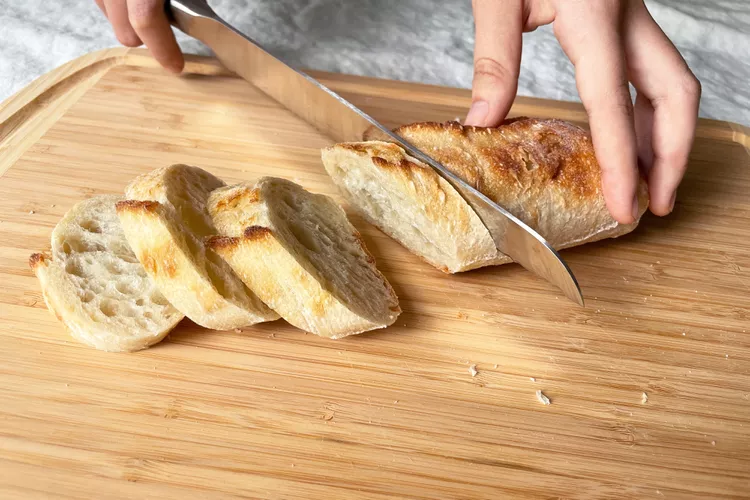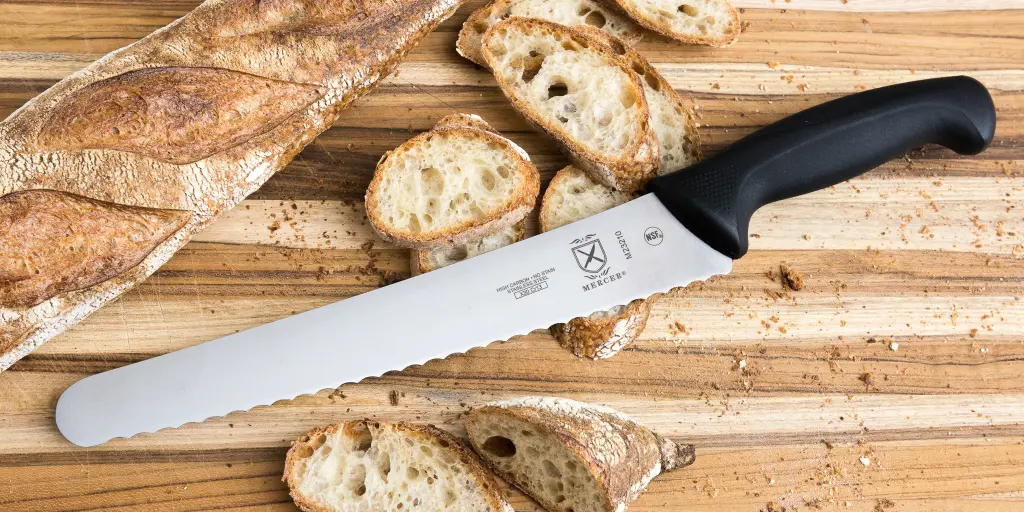Baking perfection requires the appropriate tools. Bakers need bread knives. What is a bread knife and why is it necessary? This guide will cover bread knives’ function, design, and types. This page covers bread knives for professional and amateur bakers.
What is a Bread Knife?
Bread knives are kitchen knives designed for cutting bread. Its serrated blade slices bread without crumbling or tearing.
The blade’s serrations, like small, sharp teeth, grip the bread’s surface for stability and precision. Bread knives are usually 8–10 inches long, however they can be smaller or larger to suit specific needs.
The Purpose of a Bread Knife
Bread blades are designed to cut crispy loaves without damaging their texture. Bread blades can cut through resistant crusts while protecting the sensitive core with their serrated edges. This ensures precise, flatbread-free pieces. Bread blades may also slice pastries, tomatoes, and citrus fruits.
Types of Bread Knives

Common bread knives:
Serrated Bread Knife: Most frequent. Its serrated blade has tiny, sharp teeth. The serrations grasp the bread crust for precise and easy slicing without crushing or shredding it.
Offset Bread Knife: An offset bread knife has an angled blade and handle. This offset design lets you cut bread without hitting the cutting board. It improves slicing leverage and control.
Scalloped Bread Knife: Round serrations instead of pointed teeth. These rounded serrations allow the knife to slice bread easily without squishing.
Double-Edge Bread Knife: This knife has serrations on both sides. This design lets you cut bread and other foods on either side of the blade.
Japanese Bread Knife: Japanese bread knives are slimmer and sharper than Western bread knives, inspired by traditional Japanese blades. Its razor-sharp edge and serrations allow for precise, clean cuts.
Electric Bread Knife: Electric bread knives include a reciprocating blade that slices bread easily. These knives are useful for huge amounts of bread or people who have trouble using manual knives.
Bread Knife with Guided Slicing Blade: A guided slicing blade helps maintain slice thickness. This is useful for presenting baked goods or making sandwiches with consistent slices.
How to Choose the Right Bread Knife

To choosing the perfect bread knife, consider a few aspects.
Blade Length
Bread knife blade length impacts how much bread you can comfortably slice. A 10-inch blade is best for large loaves and artisan bread. 8–9-inch blades work for smaller loaves and rolls.
Blade Material
sharp longer. Damascus steel is strong and beautiful.
Handle Style
Bread knife handles affect comfort and control. Find an ergonomic, secure handle. Handles are made of wood, plastic, or composites. Choose a handle that fits your hand and makes the knife easy to use.
Price Range
Bread knives range from affordable to professional-grade. Quality bread knives work better and last longer. Select the best knife within your budget.
Maintaining Your Bread Knife

Proper bread knife maintenance ensures durability and performance. Bread knife care:
Handwashing: Wash your bread knife after every usage. It can rust or corrode if left in the sink or dishwasher.
Gentle Cleaning: Clean the knife with mild dishwashing soap and a gentle sponge or cloth. Abrasive scrubbers and aggressive cleaning solvents might harm the blade.
Drying and Storing: After washing, dry and store the knife. Keep the knife in a knife block or on a magnetic strip to prevent mishaps.
Sharpening: Bread knife serrations dull over time. Maintain cutting performance with a serrated knife sharpener or a professional sharpener.
Questions (FAQs)
Which bread knife technique works best?
Use a bread knife at a little angle to saw through bread. Avoid smashing the loaf by applying minimum downward pressure.
Bread knives: multipurpose?
Bread knives can slice delicate delicacies like cakes, tomatoes, and citrus fruits. It cannot slice bones or difficult vegetables.
Bread knife sharpening frequency?
Use determines sharpening frequency. Every six to twelve months or when cutting performance decreases, sharpen your bread knife.
Bread knives: dishwasher-safe?
Dishwasher-safe bread knives should be hand washed. Dishwashers’ high heat and harsh detergents might ruin the knife’s blade and handle.
Bread knives for lefties?
Many bread knives are right- and left-handed. For comfort, choose ambidextrous or symmetrical knives.
Any bread knife safety tips?
Use bread knives carefully. Cut away from your body and fingers. Use a non-slip cutting board to avoid mishaps.
Conclusion
Every baker needs a bread knife to cut crusty bread cleanly and evenly. A bread knife’s serrated blade and ergonomic form allow for precise, flawless slices. A good bread knife is vital for baking, whether you’re a pro or a home cook.
This article covered bread knife kinds, uses, and upkeep. When choosing a bread knife, consider blade length, material, handle design, and budget. Handwashing, mild cleaning, and regular sharpening will extend the life and functionality of your knife.
After learning about bread knives, improve your baking. Cut crusty loaves, cakes, and delicate pastries uniformly to wow friends and family.
